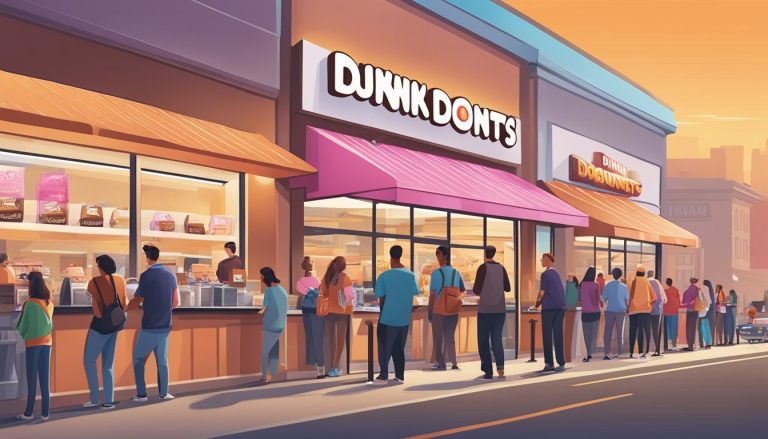Dunkin’s global expansion has been fueled by its innovative approach to menu localization. The company has skillfully adapted its breakfast offerings to cater to diverse cultural tastes and preferences around the world. By tailoring menu items to suit regional palates, Dunkin’ has successfully transformed from an American doughnut chain into a respected international brand.
This strategic localization extends beyond mere food adaptations. Dunkin’ incorporates local customs and traditions into its marketing campaigns, creating a deeper connection with customers in various countries. For example, in South Korea, the company partnered with a popular K-pop group to launch limited-edition beverages and merchandise, aligning with the country’s vibrant pop culture scene.
Dunkin’s menu localization efforts have resulted in unique offerings across different markets. In China, customers can enjoy dried pork and seaweed doughnuts, while Singapore locations serve wasabi cheese and seaweed cheese varieties. These culturally-specific items demonstrate Dunkin’s commitment to embracing local flavors while maintaining its core brand identity as a beloved breakfast destination.
Dunkin’s Brand Evolution

Dunkin’ has undergone significant changes to its brand identity and target market over the years. These shifts reflect the company’s efforts to stay relevant and appeal to a broader audience.
Rebranding and Visual Identity
In 2018, Dunkin’ Donuts made a bold move by dropping “Donuts” from its name. This rebranding aimed to emphasize the chain’s beverage offerings, particularly coffee. The new logo retained the iconic pink and orange colors but simplified the design.
The updated visual identity featured a more modern, streamlined look. Dunkin’ introduced new packaging, store designs, and marketing materials to reflect this change. The company also adopted a more playful tone in its advertising campaigns.
This rebranding effort helped Dunkin’ position itself as a beverage-led, on-the-go brand. It sought to compete more directly with coffee-focused chains like Starbucks.
Expanding the Customer Base
Dunkin’ has strategically broadened its appeal beyond its traditional core of donut and coffee enthusiasts. The company introduced healthier menu options, including egg white sandwiches and plant-based alternatives.
To attract younger consumers, Dunkin’ embraced digital technology. They launched a mobile app for ordering and payments, and partnered with food delivery services. The brand also increased its presence on social media platforms.
Dunkin’ expanded its beverage lineup to include cold brew, nitro coffee, and specialty teas. These additions catered to evolving consumer tastes and preferences. The company also introduced seasonal flavors and limited-time offers to create buzz and drive repeat visits.
Localizing Menu Offerings

Dunkin’ adapts its breakfast menu to cater to diverse regional tastes and preferences worldwide. This localization strategy ensures the brand’s relevance and appeal in different markets.
Regional Breakfast Preferences
Dunkin’ carefully studies local breakfast habits in each market. In Asia, the company offers rice-based breakfast items and savory donuts. South Korean outlets serve Bagel Balls, a popular local treat. Chinese customers can enjoy dried pork and seaweed donuts.
In India, Dunkin’ has introduced vegetarian options to accommodate dietary restrictions. The menu includes items like the Veggie Burger and Spinach & Corn Sandwich.
European locations feature more croissants and pastries to align with continental breakfast traditions. In the UK, porridge and bacon sandwiches have been added to the menu.
Catering to Local Tastes
Dunkin’ incorporates local flavors and ingredients into its core offerings. In Singapore, customers can find Wasabi cheese and seaweed cheese donuts. The company has partnered with popular brands in various countries to create unique flavor combinations.
In Japan, Dunkin’ offers matcha-flavored donuts and beverages. Middle Eastern outlets serve date-flavored drinks during Ramadan. In Brazil, the menu includes açaí bowls and pão de queijo (cheese bread).
These localized items help Dunkin’ compete with local bakeries and cafes by offering familiar tastes in a convenient format.
Seasonal Offerings in Different Markets
Dunkin’ introduces limited-time seasonal items tailored to each market. In the US, pumpkin-flavored items appear in fall, while peppermint-flavored drinks are popular during winter holidays.
Japanese locations offer sakura (cherry blossom) themed items in spring. German outlets feature apple strudel donuts during Oktoberfest. In India, special mango-flavored beverages are available during the summer mango season.
These seasonal offerings create excitement and drive repeat visits. They also demonstrate Dunkin’s commitment to embracing local cultures and traditions, enhancing brand loyalty in international markets.
Strategic Market Expansion
Dunkin’ has pursued an aggressive global growth strategy focused on entering new international markets and adapting to local consumer preferences. The company leverages market research, strategic partnerships, and a flexible franchise model to drive expansion.
Market Research and Consumer Trends
Dunkin’ conducts extensive market research to understand local tastes and trends before entering new markets. The company analyzes demographic data, consumer behavior, and competitive landscapes. This informs menu localization efforts and marketing strategies.
Key focus areas include:
- Beverage preferences (coffee vs. tea cultures)
- Popular flavor profiles
- Dietary restrictions and health trends
- Typical meal times and consumption habits
Dunkin’ also tracks global food and beverage trends to identify emerging opportunities. This allows the brand to develop innovative products that appeal to evolving consumer tastes.
International Markets and Growth Strategy
Dunkin’ has expanded to over 40 countries outside the United States. The company targets markets with growing middle classes and increasing demand for convenient food and beverage options. Key growth regions include:
- Asia Pacific (China, South Korea, India)
- Middle East (UAE, Saudi Arabia)
- Latin America (Mexico, Brazil)
- Europe (Germany, Spain)
Dunkin’ tailors its approach for each market. In some countries, it focuses on traditional stores. In others, it explores non-traditional locations like airports and gas stations. The brand also adjusts store designs and layouts to suit local preferences.
Franchise Model and Local Partnerships
Dunkin’ relies heavily on franchising for international expansion. This model allows for rapid growth while leveraging local expertise. The company seeks franchisees with:
- Strong financial resources
- Deep understanding of local markets
- Experience in food service or retail
Dunkin’ provides franchisees with operational support, marketing assistance, and supply chain resources. The company also forms strategic partnerships with local food and beverage companies. These collaborations help Dunkin’ navigate regulatory hurdles and adapt products for regional tastes.
Marketing and Advertising Initiatives

Dunkin’ employs diverse marketing and advertising strategies to promote its localized breakfast menu offerings. The company leverages digital platforms, traditional media, and targeted campaigns to reach customers across different markets.
Digital Marketing and Social Media
Dunkin’ utilizes various digital channels to engage with its audience. The brand maintains active profiles on popular social media platforms like Facebook, Instagram, and Twitter. These platforms serve as hubs for sharing new menu items, promotions, and customer interactions. Dunkin’ also employs influencer partnerships to expand its reach and credibility among younger demographics.
Email marketing campaigns keep subscribers informed about limited-time offers and seasonal specials. The Dunkin’ mobile app plays a crucial role in the company’s digital strategy, offering personalized deals, loyalty rewards, and convenient ordering options. Geotargeted ads and location-based push notifications help drive foot traffic to nearby stores.
Traditional Advertising and Brand Messaging
Television commercials remain a key component of Dunkin’s advertising mix. These ads often highlight the brand’s commitment to quality ingredients and showcase new breakfast menu items. Radio spots and billboard advertisements reinforce brand awareness in local markets.
Dunkin’s brand messaging emphasizes convenience, affordability, and menu variety. The company’s iconic “America Runs on Dunkin'” slogan underscores its position as a go-to destination for busy consumers. In-store signage and packaging designs reflect the brand’s vibrant color scheme and reinforce key marketing messages.
Targeted Campaigns and Collateral
Dunkin’ develops targeted campaigns to appeal to specific customer segments and markets. These initiatives often incorporate local flavors and cultural preferences into menu offerings and promotional materials. Limited-time promotions, such as holiday-themed beverages and seasonal donut flavors, create a sense of urgency and drive store visits.
The company produces various marketing collateral, including brochures, menu boards, and point-of-sale displays. These materials showcase the brand’s localized breakfast options and highlight nutritional information. Dunkin’ also partners with local events and organizations to increase brand visibility and demonstrate community involvement.
Customer Engagement and Loyalty

Dunkin’ has implemented several strategies to foster customer loyalty and enhance engagement. These efforts span loyalty programs, customer feedback mechanisms, and community-focused initiatives.
Loyalty Programs and Rewards
Dunkin’s DD Perks program stands at the forefront of its customer loyalty efforts. Members earn points for purchases, which can be redeemed for free beverages. The program offers personalized offers based on individual purchase history, encouraging repeat visits. For example, a customer who frequently buys coffee in the morning might receive a special offer for a breakfast sandwich.
DD Perks also provides birthday rewards and exclusive member-only promotions. The program’s mobile app integration allows for easy point tracking and reward redemption, enhancing the user experience.
Customer Satisfaction and Feedback
Dunkin’ prioritizes customer feedback to improve its products and services. The company utilizes various channels to gather input, including in-store surveys, social media monitoring, and its mobile app.
Feedback is used to refine menu offerings, adjust store operations, and enhance overall customer experience. Dunkin’ has implemented a “Guest Satisfaction Survey” system, inviting customers to share their opinions after each visit.
The company also employs mystery shoppers to assess store performance and ensure consistency across locations.
Community and Digital Engagement
Dunkin’ actively engages with local communities through various initiatives. The company sponsors local events, sports teams, and charitable organizations to build brand goodwill and strengthen community ties.
On the digital front, Dunkin’ leverages social media platforms to connect with customers. The brand maintains active profiles on Instagram, Twitter, and Facebook, sharing promotional content, responding to customer inquiries, and running interactive campaigns.
Dunkin’ has also embraced influencer marketing, partnering with social media personalities to reach younger demographics. These collaborations often result in limited-time menu items or merchandise, generating buzz and driving engagement.
Innovating the Culinary Experience

Dunkin’ has embraced culinary innovation to stay competitive and meet evolving consumer demands. The company focuses on product diversification, health-conscious offerings, and exclusive selections to enhance its menu and attract a wider customer base.
Product Innovation and Diversification
Dunkin’ continuously expands its product offerings to cater to diverse tastes. The company introduces seasonal items and limited-time offers to generate excitement and drive traffic. Recent additions include savory breakfast sandwiches, plant-based options, and unique donut flavors.
Dunkin’ collaborates with food scientists and chefs to develop new recipes. This approach ensures a balance between traditional favorites and innovative creations. The brand also leverages customer feedback and market research to inform its product development process.
To streamline operations, Dunkin’ implements efficient cooking methods and equipment. This allows for quick preparation of new menu items without compromising quality or speed of service.
Adapting to Health-Conscious Trends
Recognizing the growing demand for healthier options, Dunkin’ has introduced several menu items targeting health-conscious individuals. The company now offers low-calorie breakfast sandwiches, egg white options, and whole grain breads.
Dunkin’ has also expanded its beverage lineup to include sugar-free flavorings and non-dairy milk alternatives. These additions cater to customers with dietary restrictions or those seeking lower-calorie options.
Nutritional information is prominently displayed, allowing customers to make informed choices. Dunkin’ continues to explore ways to reduce artificial ingredients and incorporate more natural elements into its products.
Exclusive Coffee and Bakery Selections
Dunkin’ aims to appeal to coffee enthusiasts with its premium coffee offerings. The company has introduced single-origin coffees and limited-edition blends to showcase its commitment to quality.
Cold brew and nitro cold brew options have been added to meet the growing demand for specialty iced coffees. Dunkin’ also offers customizable espresso drinks, allowing customers to create personalized beverages.
In the bakery section, Dunkin’ has introduced artisanal-style donuts and pastries. These premium items feature unique flavor combinations and high-quality ingredients. Limited-time bakery offerings create a sense of exclusivity and encourage repeat visits.
Operational Excellence and Customer Convenience

Dunkin’ has built its success on a foundation of operational efficiency and customer-focused convenience. The brand’s strategies encompass quick-service restaurant principles, digital innovations, and streamlined in-store experiences.
Quick-Service Restaurant Model
Dunkin’ exemplifies the quick-service restaurant (QSR) model, prioritizing speed and efficiency. The brand’s stores are designed with minimal seating, focusing on takeout and drive-thru services. This layout reduces overhead costs and maximizes serving capacity during peak hours.
Dunkin’ emphasizes a streamlined menu of coffee, donuts, and breakfast items. This approach allows for faster preparation times and consistent quality across locations. The simplified offerings also enable staff to maintain efficiency even during rush periods.
Drive-thru services are a cornerstone of Dunkin’s QSR model. These allow customers to order and receive their food without leaving their vehicles, significantly reducing wait times and enhancing convenience.
Mobile App and On-The-Go Ordering
Dunkin’s mobile app stands as a key component of its digital strategy. The app offers customers the ability to order ahead, skip lines, and earn rewards. This technology aligns with modern consumer preferences for quick, contactless transactions.
On-the-go ordering through the app allows customers to place orders in advance and pick up at their convenience. This feature reduces in-store wait times and improves overall customer flow.
The app also serves as a digital loyalty program. Customers earn points on purchases, which can be redeemed for free items. This system encourages repeat visits and strengthens brand loyalty.
Efficient In-Store Experiences
Dunkin’ has optimized its in-store operations to enhance customer experiences. Stores feature clearly displayed menu boards and efficient counter layouts to facilitate quick ordering.
Self-service kiosks have been introduced in some locations. These allow customers to place orders directly, reducing wait times and freeing up staff to focus on order preparation and delivery.
Dunkin’ employs efficient food preparation methods. Many items are prepared in advance during off-peak hours, allowing for quick assembly during busy periods. This approach ensures fresh products are always available while maintaining swift service.
The brand also focuses on staff training to maintain operational standards. Employees are trained in efficient order-taking, food preparation, and customer service techniques to uphold Dunkin’s commitment to speed and quality.
Leveraging Strategic Alliances

Dunkin’ has forged strategic partnerships to expand its reach and enhance its breakfast offerings. These collaborations allow the company to tap into new markets and create unique products that appeal to diverse customer tastes.
Partnerships With Like-Minded Brands
Dunkin’ teams up with popular brands to create limited-edition menu items. These partnerships generate buzz and attract new customers. For example, Dunkin’ collaborated with Hershey’s to introduce chocolate-flavored coffee drinks and donuts.
The company also works with local brands in different countries to develop region-specific treats. In South Korea, Dunkin’ partnered with a K-pop group to launch a special beverage line, appealing to the country’s youth culture.
Cross-Promotional Efforts
Dunkin’ engages in cross-promotional activities with complementary businesses. The company often pairs up with entertainment franchises to offer themed products and promotions.
During major sporting events, Dunkin’ collaborates with teams and athletes to create special menu items. These partnerships boost brand visibility and drive foot traffic to stores.
Seasonal promotions, such as Valentine’s Day specials, are often developed in conjunction with popular confectionery brands.
Collaborations With Food and Beverage Giants
Dunkin’ has formed strategic alliances with major food and beverage companies to expand its product range. The partnership with Coca-Cola led to the introduction of bottled iced coffee drinks sold in retail stores.
The company’s collaboration with Beyond Meat resulted in the launch of plant-based breakfast sandwiches, catering to the growing demand for vegetarian options.
Dunkin’s long-standing relationship with sister brand Baskin-Robbins has led to innovative crossover products, such as ice cream-flavored coffees and donut-inspired ice cream flavors.
Conclusion

Dunkin’s breakfast menu localization efforts demonstrate a sophisticated global marketing strategy. The brand adapts its offerings to suit regional tastes and preferences across diverse markets.
This approach strengthens Dunkin’s market positioning in various countries. By tailoring menu items, the company shows cultural sensitivity and appeals to local consumers.
Strategic partnerships play a key role in Dunkin’s international expansion. Collaborations with local entities help the brand resonate with target audiences in different regions.
Dunkin’s localization extends beyond food items to marketing campaigns. The company incorporates local customs and traditions into its promotional efforts, enhancing brand relevance.
These tactics contribute to Dunkin’s strong brand positioning worldwide. The company maintains its core identity while flexibly adjusting to local market demands.
Dunkin’s success in menu localization serves as a model for global brands. It highlights the importance of balancing standardization with customization in international markets.




